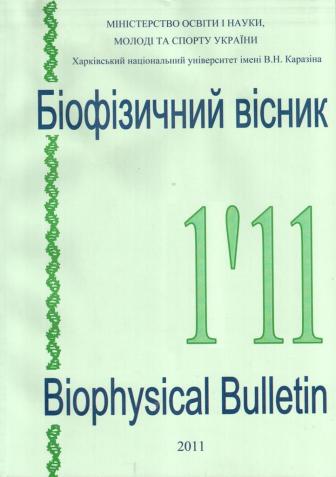Комплексоутворення ароматичних біологічно активних сполук з антибіотиком топотеканом: аналіз за даними 1h ямр спектроскопії
Анотація
У даній роботі з використанням даних 1H ЯМР спектроскопії проведено аналіз гетероасоціації
антибіотика топотекану (TPT) з ароматичними біологічно активними сполуками (БАС): кофеїном,
мутагенами бромистим етидієм і профлавіном, антибіотиком дауноміцином, вітамінами флавінмононуклеотидом і нікотинамідом. Аналіз проведено з урахуванням існування антибіотика у
водному середовищі при фізіологічних pH у двох різних формах - лактонной і карбоксилатной.
Отримани рівноважні константи гетероасоціації і індуковані хімічні зсуви протонів TPT (у
лактонній і карбоксилатній формах) і БАС у складі комплексів. Встановлено, що
комплексоутворення TPT-БАС носить характер стекінгу хромофорів, додатково стабилизируемого
у разі профлавіна міжмолекулярними водневими зв'язками.
Завантаження
Посилання
2. Graves D.E., Velea L.M. Intercalative binding of small molecules to nucleic acids // Curr. Org. Chem. - 2000. - V.4. - P.915-928.
3. Evstigneev M.P. DNA-binding aromatic drug molecules: Physico-chemical interactions and their biological roles. - Lambert Academic Publishing., 2010. - 96 p.
4. Traganos F., Kapuscinski J., Gong J., Ardelt B., Darzynkiewicz R. J., Darzynkiewicz Z. Caffeine prevents apoptosis and cell cycle effects induced by camptothecin or topotecan in HL-60 cells // Cancer Res. – 1993. – V.53. – P.4613 - 4618.
5. Лантушенко А.О., Мосунов А.А., Даржинкевич З., Евстигнеев М.П. Протекторное действие витамина B2 по отношению к антибиотику топотекану in vitro // Физика живого. – 2007. – Т.15. – С.18-23.
6. Bernacki R.J., Pera P., Gambacorta P., Brun Y, Greco W.R. In vitro antitumour activity of 9-Nitro-camptothecin as a single agent and in combination with other antitumour drugs // Ann. N.Y. Acad. Sci. -2000. - P.293-297.
7. Gabr A., Kuin A., Aalders M. Cellular pharmacokinetics and cytotoxicity of camptothecin and topotecan at normal and acidic pH // Cancer Res. – 1997. – V.57. – P.4811-4816.
8. Mazzini S., Bellucci M.C., Dallavalle S., Fraternali F., Mondelli R Mode of binding of camptothecins to double helix oligonucleotides // Org. Biomol. Chem. – 2004. – V.2. – P.505-513.
9. Bocian W., Kawecki R., Bednarek E., Sitkowski J., Pietrzyk A., Williamson M.P., Hansen P. E., Kozerski L. Multiple binding modes of the camptothecin family to DNA oligomers // Chem. Eur. J. – 2004. – V.10. – P. 5776-5787.
10. Бучельников А.С., Евстигнеев В.П. Моделирование многокомпонентного равновесия биологически активных ароматических молекул в водном растворе // Вестник СевНТУ (серия Физика и математика). – 2009. – Вып. 99. – С.3-11.
11. Мосунов А.А., Симонова С.Н., Розвадовская А.О. Исследование самоассоциации антибиотика топо-текана // Вестник СевГТУ (серия Физика и математика). – 2007. – Т.85. – С.54-58.
12. Evstigneev M.P., Evstigneev V.P., Davies D.B. A method for analysis of multicomponent systems of inte-racting aromatic molecules in solution // J. Chem. Phys. – 2007. – V. 127. – P. 154511-7.
13. Евстигнеев В.П., Мосунов А.А., Евстигнеев М.П. Решение задачи об одномерной некооперативной самосборке невалентного типа в двухкомпонентной системе // Хим. физика (направлена в печать).
14. Евстигнеев В.П. Многокомпонентные взаимодействия ароматических биологически активных соеди-нений и ДНК в водном растворе: дис. кандидата физ.-мат. наук: 03.00.02 / Евстигнеев Владислав Павло-вич. – Х., 2009.
15. Davies D.B., Veselkov D.A., Kodintsev V.V., Evstigneev M.P., Veselkov A.N. 1H NMR investigation of the hetero-association of aromatic molecules in aqueous solution: factors involved in the stabilization of complexes of daunomycin and acridine drugs // Molecular Phys. - 2000. - Vol.98, №23. - P.1961-1971.
16. Веселков А.Н., Лантушенко А.О., Евстигнеев М.П., Веселков Д.А., Дэвис Д.Б. Сравнительный анализ гетероассоциации азидо-аналогов этидия с антибиотиком дауномицином в водном растворе по данным 1H-ЯМР спектроскопии // Укр. химич. журнал. - 2002. - Т.68. - С.78 - 83.
17. Костюков В.В., Твердохліб Н.М., Євстигнєєв М.П. Енергетичний аналіз комплексоутворення арома-тичних молекул у водному розчині // Укр.фізич.журн. - 2011. – Т.56, №1. – С.38-49.
18. Kostjukov V.V., Mosunov A.A., Ermolaev M.A., Sykhonos P.A., Evstigneev M.P. Additional stabilization of hetero-complexes of aromatic molecules: H-bonds or charge-transfer? // J.Mol.Str. – 2011. – V. 985. – P.403-406
Автори, які публікуються у цьому журналі, погоджуються з наступними умовами:
- Автори залишають за собою право на авторство своєї роботи та передають журналу право першої публікації цієї роботи на умовах ліцензії Creative Commons Attribution License, котра дозволяє іншим особам вільно розповсюджувати опубліковану роботу з обов'язковим посиланням на авторів оригінальної роботи та першу публікацію роботи у цьому журналі.
- Автори мають право укладати самостійні додаткові угоди щодо неексклюзивного розповсюдження роботи у тому вигляді, в якому вона була опублікована цим журналом (наприклад, розміщувати роботу в електронному сховищі установи або публікувати у складі монографії), за умови збереження посилання на першу публікацію роботи у цьому журналі.
- Політика журналу дозволяє і заохочує розміщення авторами в мережі Інтернет (наприклад, у сховищах установ або на особистих веб-сайтах) рукопису роботи, як до подання цього рукопису до редакції, так і під час його редакційного опрацювання, оскільки це сприяє виникненню продуктивної наукової дискусії та позитивно позначається на оперативності та динаміці цитування опублікованої роботи (див. The Effect of Open Access).




